- MIlk powder is a popular household item.
- Its key ingredient is naturally gluten-free.
- The powdered form of milk may contain gluten.
- The list of ingredients or the GF label can confirm its status.
Do you love to start your day with caramel-colored tea or coffee? A popular way to get your morning cuppa ready is by adding a spoonful of powdered milk. But coloring your hot beverage is not the only use of milk powder. It has many other uses. But is powdered milk gluten-free and safe for you?
From dessert toppings to condensed milk, from yogurt to a bowl of oats – milk powder can add taste to anything that needs milk – conveniently and cheaply. The key ingredient of milk powder is naturally gluten-free. But the additives in it can have gluten. So check the list of ingredients while buying a brand.
Is Powdered Milk Gluten-Free – What is Powdered Milk?
Powdered milk is a common item in every household. It’s mostly used as a creamer for beverages. People also use it as a replacement for regular milk in many milk-based dishes or food items. It’s nothing but dry milk in the form of powder. So, powdered milk is gluten-free, as milk is naturally free from gluten.
As we all know, fresh milk comes from animals. So, it is in no way associated with gluten grains like wheat, barley, and rye. Powdered milk is made by evaporating milk to make it dry and last longer. So, it should be gluten-free, too, except it can contain additives like preservatives, flavoring agents, and more.
These additives may be naturally gluten-rich. Many brands use such gluten-containing additives in their products, rendering them unsafe for people who have celiac disease. Besides, both the additives and the actual milk powder have the chance of ending up with gluten content due to cross-contamination.
So, you must check the list of ingredients at the time of purchasing powdered milk. Most brands name gluten ingredients on the label. Some brands also make it a point to mention if their milk powder, made without any gluten-containing ingredients, shares facilities with other gluten products.
People with celiac disease or gluten allergy trust milk powder brands that do not mention gluten ingredients on their label unless they are severely allergic. In that case, even trace gluten can hurt you. So, it is best to choose a milk powder brand that flaunts the “gluten-free” label on its container.
This label is proof that the ingredients of the milk powder and the final product are tested and proven to contain less than the permitted limit of gluten content, i.e., 20 ppm. This sign also tells you that the facilities where the product was manufactured, processed, or packed don’t handle gluten products.
Is Non-Dairy Milk Powder Gluten Free?
Let’s also not forget non-dairy milk powder alternatives derived from plant sources. While these are not the first things that we think of when we mention milk powder, a lot of people with lactose intolerance are shifting to them. It is important to check the ingredients used to make dairy-free powdered milk.
Unlike regular milk powder, the plant-based versions may be made of coconut, almond, soy, rice, and other lactose-free sources. Like regular milk powder, the non-dairy one may also contain gluten-rich additives, besides having gluten-containing ingredients. Or it could undergo cross-contamination.
So, the same theory applies to non-dairy milk powder, as well, i.e., take a look at the label to detect gluten ingredients that might be present in the powder. However, if you are severely allergic, it is always better to look for a dairy-free milk powder alternative tested and certified as gluten-free and safe.
Advantages of Milk Powder
Powdered milk is a useful product in every household. Most families use milk powder regularly because it is convenient to use and also lasts longer. That’s because powdered milk is made by evaporating milk in its liquid format till it becomes dry. The process of dehydration helps to preserve the milk.
The shelf life of powdered milk is longer than liquid milk because of the lack of moisture content. Dry milk does not require refrigeration, either. So, powdered milk is less demanding when it comes to storage. As long as you keep it in a cool, dry place, it can last for as long as 3 months after being opened.
Easy storage and long shelf life are not the only advantages of dry milk. Another useful purpose of milk powder is easy transportation. 1 cup of liquid milk can be replaced with 1/4th cup of milk powder. So, it is more space-efficient. It is also easy to use in different recipes, other than using it in beverage creamer.
Surprising Uses of Milk Powder
If you are allergic to gluten, it’s likely you already have the habit of making a lot of the foods at home, unlike other people who have the freedom to enjoy buying foodstuff off the shelves whenever they want. You will be pleasantly surprised to know what kind of recipes milk powder can help you make!
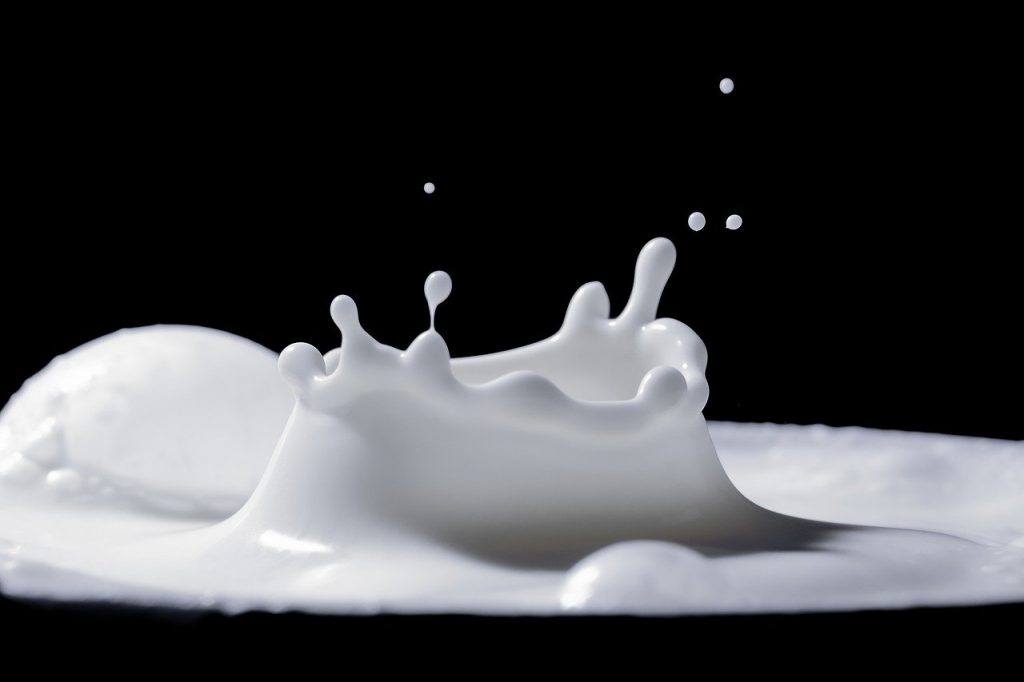
- Regular Milk Alternative – You can turn milk powder into liquid milk and use it in different recipes, from your breakfast oats bowl to a cake, pancake, or desserts. All you have to do is mix ⅓ cup of powder with 1 cup of water to get the perfect milk consistency. This is an easy way to add milk content to make anything that needs milk.
- Evaporated milk – Evaporated milk comes in handy to enhance the taste and texture of smoothies, chowders, sauces, and more. Just mix 1 cup of milk powder and two tbsp of oil with 1 ½ cups of water to make 12 oz.
- Sweetened Condensed Milk – So many delicious desserts can be made using condensed milk, right? Cakes, pies, dessert sauces – it can go into anything. To avoid running to the grocery store, you can make 14 oz of condensed milk at home by mixing 1 cup of powdered milk, 1 cup of sugar, and ½ cup hot water. Then blend everything.
- Sour Cream – Sour cream is more than just your regular dip for chips. Sandwiches, salads, baked goodies – everything can become better with just a touch of sour cream because of its rich flavor and texture. To make some sour cream at home, you have to put together ¾ cup of plain yogurt and ⅓ cup of powdered milk.
- Buttermilk – Also known as sour milk, buttermilk is perfect for cookies, muffins, waffles, and pancakes. You can even use it to make marinades to tenderize meat. To make it, take ¼ cup of milk powder and add 1 cup of water and 1 tbsp of lemon juice. Let it rest for 5-10 min to make your own version of buttermilk.
- Yogurt – Do you know how homemade yogurt needs some previously-made yogurt? This recipe is like that. Mix 1 ⅓ cups of milk powder and 3 ¾ cups of water. Then add another ½ cup of powdered milk. Set it over low heat until it hits 110 degrees. Add ¼ cup of yogurt, mix, and let it stand for a day in a warm spot!
- Cream Cheese – This recipe starts with making yogurt. Then, please place it in a dish towel or muslin and hang it over a large bowl using a wooden spoon. When the whey gets drained out for 12-24 hours to get delicious cream cheese, to enjoy the rich decadence of cream cheese at home, you can try this easy recipe with milk powder!
- Ricotta/Cottage Cheese – Mix 6 cups of water with 3 cups of milk powder and heat it to 110-120 degrees. Turn off the heat and add ½ cup of vinegar. Stir until the curd and whey separate. Drain off the whey and rinse before adding some milk or cream and salt to get ricotta cheese or cottage cheese with an unbeatable, rustic taste!
- Pudding Powder – Forget those store-bought pudding mixes and make your own by mixing 8 cups of milk powder with 4 cups of sugar and 4 cups of corn starch, along with 1 tsp of salt. Use a cup of this mix with 3 cups of boiling water and add 1 tbsp of butter and 1 tsp of vanilla. Add the water slowly and stir till it thickens.
- White Sauce – To make some basic white sauce, put a saucepan on low heat, add ⅓ cup of milk powder, 3 tbsp of butter, and 3 tbsp of the gluten-free flour mix. Add a cup of water in a slow stream to get a thick white sauce. To this, you can add cheese, spices of your choice, veggies, or meat, and enjoy a delicious white sauce!
- Whipped Topping – Take a chilled bowl in an ice bath and add ½ cup of ice-cold water. Then, add ½ cup of milk powder and use a beater to mix. Add ½ cup of sugar slowly while beating. Finally, add the lemon juice, and mix until stiff. Easy, right? If you think that nothing can replace real whipped cream, you should try this topping.
- Chocolate Milk Mix – Who doesn’t love chocolate milk? A cup of it can take away the stress of the day and make sleep easy. Make chocolate milk powder, take 4 cups of powdered milk and mix it with 1 cup cocoa and ¾ cup of sugar, with ½ tsp of salt. To make a cup of chocolate milk, take ½ cup of this mix and add 1 cup of water.
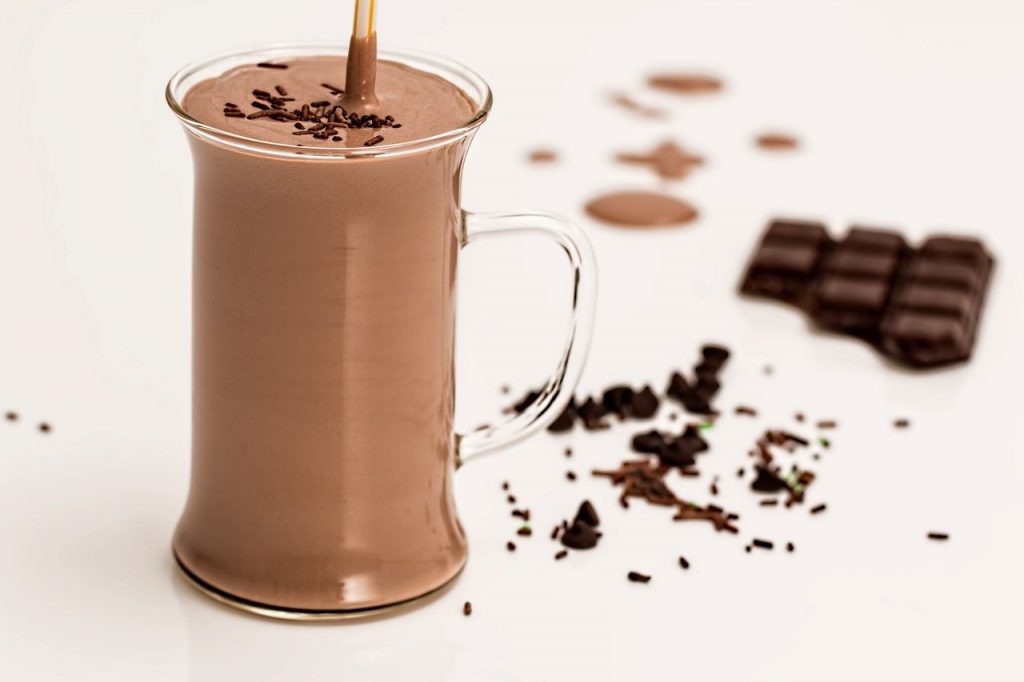
So you see, powdered milk is more than just a creamer and it can easily replace milk in multiple recipes in your gluten-free lifestyle. Oh, and just so you know, powdered milk is also a great ingredient in face packs, hair packs, moisturizers, makeup removers, milk baths, and much more to make you glow from head to foot!
Gluten-Free Powdered Milk Brands
Many powdered milk varieties are available in the market, either certified as gluten-free or marketed that way because of their safe ingredients. Let’s remember that even if a product is not certified, it doesn’t necessarily mean gluten-free. Let’s take a look at the safe brands:
a) Hoosier Hill Farm All American Whole Milk Powder
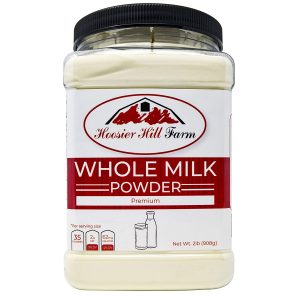
The Hoosier Hill Farm All American Whole Milk Powder proudly flaunts its gluten-free label on the container. It is also certified as a hormone-free milk powder. It’s nutrient-rich and absolutely delicious.
b) Meyenberg Canned Powdered Whole Goat Milk
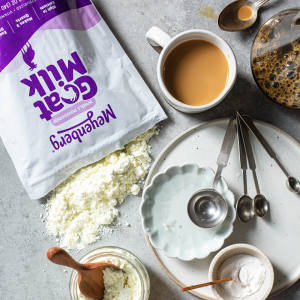
Meyenberg Canned Powdered Whole Goat Milk is whole milk turned industry milk powder for everyday use. This product is marked as naturally gluten-free on the container and is generally considered safe.
c) Anthony’s Non-Fat Milk Powder

Another popular milk powder, certified as gluten-free, is Anthony’s Non-Fat Milk Powder. It is an extremely healthy option that you can trust if you have celiac disease or gluten allergy.
d) Aadvik Camel Milk Powder
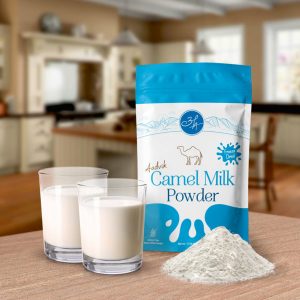
Have you ever tried camel milk? Here is your chance to try it in milk powder and use it in different recipes. Don’t worry about gluten content as it is lab-tested, as mentioned on the pack.
e) The SACO Pantry

The SACO Pantry offers both instant milk powder and buttermilk powder; both marked as gluten-free on the package. These are easy to use products that can replace liquid milk in your recipes.
There are powdered milk brands that are neither tested nor marketed as gluten-free but are trusted by the celiac community, including Organic Valley, Carnation, NIDO, and more. You can also try gluten-free, vegan brands like FG Roberts, Well Versed, Prescribed for Life, Nutricost, Yae! Organics, and more!
Gluten-Free Powdered Milk Recipe
If you are one of those people with gluten intolerance who wants to make everything at home, especially if you have children, here is a recipe that you can follow to make gluten-free and contamination-free powdered milk at home. All you need is milk – and that’s it! Take a look:
Ingredients:
- Milk (skimmed or full fat): 1 L
Instructions:
- In a shallow oven-proof dish, add the milk. It should be at room temperature. Make sure that the milk reaches up to an inch in the dish. If necessary, complete the whole process in separate batches.
- Put the dish with the milk in the oven and turn on the heat at the lowest temperature, like
- Next, place the dishes into your oven at their lowest temperature.
- Leave the oven door open just a little if you do not have a fan option to boost evaporation speed.
- Keep stirring now and then to prevent the milk from turning brown. Continue to heat until the water content dries up and leaves behind a thick paste.
- Take the paste and spread it on a tray lined with parchment paper. Then, please put it back in the oven to finish the dehydration process.
- Once the paste dries completely, remove it from the tray. The texture will be crispy.
- Snap it into flakes and put them in a grinder or blender. Then, grind them to make a fine powder.
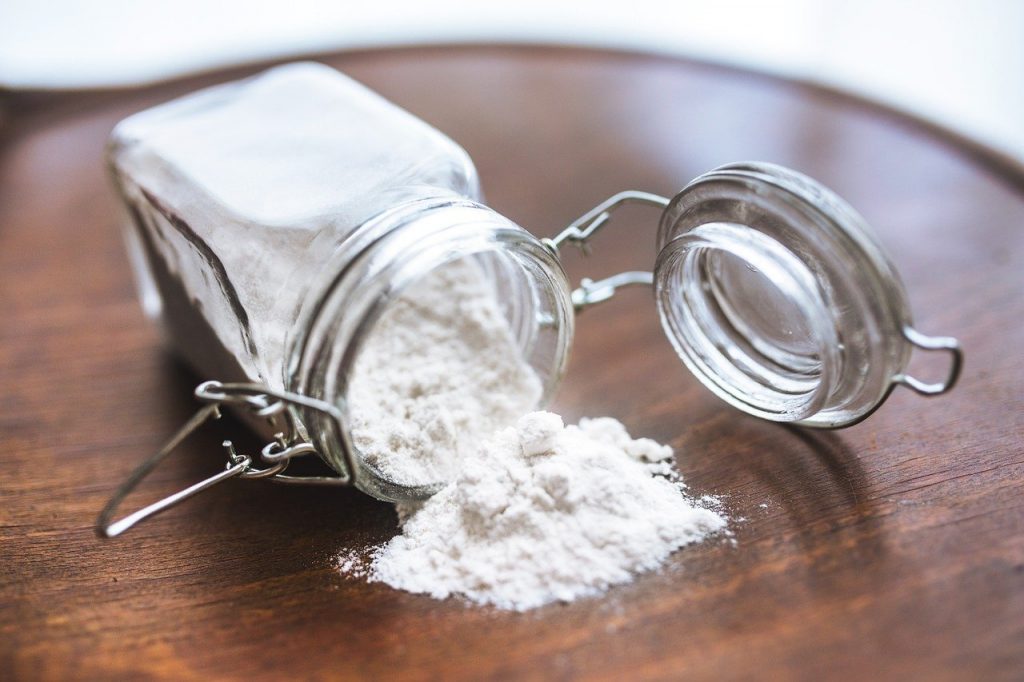
Your milk powder is ready! Store the powder in an appropriate container that you need to place in a cool and dry corner of the pantry. It can last for several months! You can perform the same process in a dehydrator, letting the evaporation take place for 8-12 hours, depending on the amount of milk.
Connection Between Celiac Disease and Lactose Intolerance
Gluten allergy and dairy allergy are two completely different things—both present various symptoms. One interesting thing is that when people are still undiagnosed with a gluten allergy or celiac disease, many of the symptoms they face may be similar to those of lactose intolerance or dairy allergy.
As a result, many people mistake gluten intolerance for lactose intolerance. The two are not the same, and being gluten intolerant does not inherently make you allergic to dairy. Celiac disease or gluten intolerance does not have any cure. The only way you can remain healthy is by avoiding gluten.
If you don’t do that and continue to eat gluten, it can cause many severe side effects. There’s also the risk of developing other health complications – including lactose intolerance. So, while the two conditions are not the same, celiac disease can eventually lead to problems with lactose digestion.
Gluten consumption causes intestinal inflammation if you are intolerant to gluten, which leads to secondary lactose intolerance. Celiac disease is an autoimmune disease that affects the small intestine. Your body considers gluten to be a harmful invader. In an attempt to stop it, it ends up harming itself.
So, eating gluten in this condition causes heavy damage to the small bowel’s lining. Both adults and children with celiac disease are prone to developing lactose intolerance if they continue to eat gluten. So, it is essential to get diagnosed as soon as the symptoms first appear to get to the root of the problems.
Interestingly, some recent studies have shown that continuing to eat dairy if you have a gluten intolerance can sabotage your gluten-free diet by causing inflammatory reactions. So, you can consider replacing dairy products, including gluten-free milk powder, with non-dairy alternatives that are available now.
Coconut, soy, rice, and nut milk are some of the most popular alternatives that are used now. You can find these in liquid and powdered form, which means that you can easily replace your regular milk powder with plant-based, dairy-free alternatives. You have to ensure that they are gluten-free.
Conclusion
Since powdered milk is made from milk, it is supposed to be naturally gluten-free. However, additives often add gluten to milk powder. The best way to ensure that your milk powder brand is safe for you is by picking a certified gluten-free brand. It’s also ideal for shifting to plant-based milk powder.